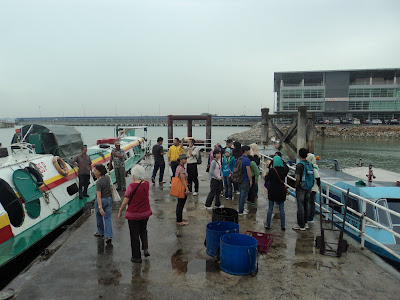Salam and Morning,,,
This morning i feel little bit upset because cannot attend an important Symposium near KLCC hosting by UPM because of my health and no transport. Its ok i will repay it back by writing something knowledgeable in here. mmmm now i feel i want to write about Nannochloropsis Culture.
Nannochloropsis is a genus of alga, 2-4 microns in diameter that is used extensively in the aquacultureindustry for growing small zooplankton such as rotifers, copepods, daphnia and Artemia. It is also used extensively in reef tanks for feeding SPS coral, newly hatch larvae such as Barramundi, Groupers, shrimp, lobster etc.
 |
| Nannochloropsis |
There are many types of media u can use to culture Nannochloropsis oculata/salina such as Conway, Guillards F formula, TMRL, Miguels etc. In this experiment i want to try use Guillard F formula and Conway media. Follow the detail below:
Lab / Room culture
Culturing Vessel Details
Salinity: 28-33 ppt
Temperature: 27-30 C
Vessel description: Cylindrical 3 liter arrowhead jugs, dimple in bottom
Light Description: Three 4 foot dual tube normal output flourescents mounted vertically on wall behind culture shelves (approx 4 inches from vessels) Sylvania 3500K bulbs currently used.
Light Cycle: 14 hours light 10 hours dark
Aeration Description: Aeration provided by rigid airline sunk to the bottom of each culture rack, no airstone is used, bubble rate is set semi rapid to provide for water to circulate at approximately 1 rotation per second.
Methodology
Split methodology: Each culture is harvested at split time, culture is then re-started using 40% of original volume with harvested 60% being replaced with ASW mixed to 1.019 and 5 ml of Guillards F formulation is added. Split are performed every 8 days.
Cell count: average 22 million cells per ml via hemocytometer cell count method.
Alright, these cultures have been running for quite a while so don't be suprised by much of the missing info.. I'll try and add as much as possible.
1) Basic culture rack construction
2) A culture before being split
For this split due to fouling of the original vessel I will be changing jugs,,, It's also important to note that I keep pre mixed ASW on hand at varying salinities in sealed jugs (which are rotated zooplankton cultures if they foul or are contaminated, never re-used for algal cultures). I do not mix my gullard solution ahead of time, this is greatly helped avoid pre-contamination.
3) Empty water jug and ASW storage container
I try to keep the distance between the petcock of the ASW jug and the bottle separated at least 3 inches when filling, this also helps to reduce contamination. When splitting, i will add the ASW first then decant the culture through 250um sieve (to remove excess detritus). If maintaining the same vessel I will decant into a holding jug and then add the ASW to the original culture (no sieving).
Because of the nature of gullards (or any other nutrients) I like to store it in opaque container to keep them out of the light. I managed to scrounge up a no. of medcine containers that feature a nifty top that allows withdrawal of the fluid using a syringe (without needle). The syringes are graduated in g but conversion is 0.5 g/ml and makes for easy measurement.
4) Nutrient (Guilliards)
5) Split culture
Note the lighter colour and also note the cloudy appearence..this was a culture that i got lazy with and didn't sieve. I probably should have this culture will be danger of crashing later.
6) Crash
Note that the abrupt clearing of water and settling of algal cells on the bottom..whoops.. In the instance of a crash airline running from the manifold all the way to the rigid, along with rigid, vessel and cap are all discarded. The manifold is shut off and the culture section remains empty for a period of few days (to avoid contamination). Because of this I will also be double checking my ASW source for contamination and if find something I will label the jug R for rotifer, and replacing it with a fresh one.
Large scale/Tanks culture
In this experiment i use Conway's medium to culture Nannochloropsis salina. The method follow from journal Walne, 1979; Gopinathan, 200). The inoculated tubes and flasks were kept under light intensity of 3000 lux (LT lutron, LX, 101 Luxmeter) at a temperature of 27-30 C. The growth of microalgae was observed daily and the cell concentration (30-40 million cells mL-1) was monitored every alternate day using haemocytometer.
Mass culture of microalage was carried out in a circular FRP tank under the light intensity (6000 lux) during peak hours of sunlight, and provided with vigorous aeration. Nutrient mixture (Urea 4g; groundnut oil cake 4 g; super phospate 10 g) was added to seawater (1 ton). The pH, dissolved oxygen (DO), temperature and salinity were maintained between 7.5-8.3, 4.1-5.5 mg/L, 25-34 C and 28-33%, respectively in the tanks..
That all Tq..:)
Continue...
























































